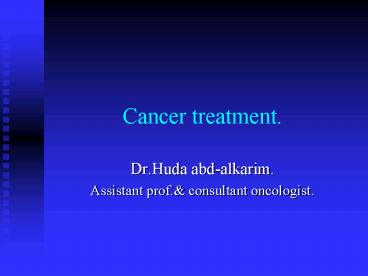Cancer treatment' PowerPoint PPT Presentation
1 / 27
Title: Cancer treatment'
1
Cancer treatment.
- Dr.Huda abd-alkarim.
- Assistant prof. consultant oncologist.
2
Objective of the lecture
- Identify the different modality of cancer
therapy.
3
Modalities of treatment
- 1-local therapy
- -surgery.
- -radiation therapy.
- 2-systemic treatment
- chemotherapy.
- Hormonal therapy.
- Monoclonal antibodies.
- Radioactive material.
- 3-supportive care.
- 4-non-conventional therapy.
4
Surgery
- Surgery was the first modality used successfully
in the treatment of cancer. - It is the only curative therapy for many common
solid tumors. - The most important determinant of a successful
surgical therapy are the absence of distant
metastases and no local infiltration.
5
Cont
- Microscopic invasion of surrounding normal tissue
will necessitate multiple frozen section. - Resection or sampling of regional lymph node is
usually indicated. - Surgery may be used for palliation in patients
for whom cure is not possible. - Has significant role in cancer prevention.
- E.g familial polyposis coli.
6
Surgery for prevention
- Patients with conditions that predispose them to
certain cancers or with genetic traits - Associated with cancer can have normal life span
with prophylactic surgery. - -colectomy .
- -oophorectomy.
- -thyroidectomy.
- -removal of premalignant skin lesion .
7
Radiation therapy
8
Radiation therapy
- Radiation therapy is a local modality used in
the treatment of cancer . - Success depend in the difference in the radio
sensitivity between the tumor and normal tissue. - It involves the administration of ionizing
radiation in the form of x-ray or gamma rays to
the tumor site. - Method of delivery External beam(teletherapy).
- Internal beam therapy(Brachytherapy).
9
Cont
- Radiation therapy is planned and performed by a
team of nurses, dosimetrists,physician and
radiation oncologist. - A course of radiation therapy is preceded by a
simulation session in which low-energy beam are
used to produce radiograghic images that indicate
the exact beam location.
10
Cont
- Radiation therapy is usually delivered in
fractionated doses such as 180 to 300 cGy per
day,five times a week for a total course of 5-8
weeks. - Radiation therapy with curative intent is the
main treatment in limited stage Hodgkins
disease,some NHL,limited stage ca
prostate,gynecologic tumorsCNS tumor . - Also can use in palliative emergency setting.
11
Complication of radiation
- There is two types of toxicity ,acute and long
term toxicity. - Systemic symptoms such as Fatigue,local skin
reaction,GI toxicity,oropharyngeal
mucositisxerostomia.myelosuppression. - Long-term sequelaemay occur many months or years
after radiation therapy. - Radiation therapy is known to be
mutagenic,carcinogenic,and teratogen,and having
increased risk of developing both secondary
leukemia and solid tumor.
12
Nuclear medicine
13
Radionuclides
- For decades have been used systemically to treat
malignant disorders. - They are administer by specialists in nuclear
medicine or radiation oncologist. - Radioactive iodinein the from of 131I is
effective therapy for well differentiated thyroid
ca - Strontium-89. Is used for the treatment of body
metastasis.it is an alkaline earth element in the
same family as calcium
14
Chemotherapy
15
Chemotherapy
- Systemic chemotherapy is the main treatment
available for disseminated malignant diseases. - Progress in chemotherapy resulted in cure for
several tumors. - Chemotherapy usually require multiple cycles.
16
Classification of cytotoxic drug
- Cytotoxic agent can be roughly categorized based
on their activity in relation to the cell cycle.
17
Cont
- What is the difference between phase specific
phase non specific?.. - Phase non-specific
- The drugs generally have a linear dose-response
curve(? the drug administration ,the ? the
fraction of cell killed). - Phase specific
- Above a certain dosage level,further increase in
drug doesnt result in more cell killing.but you
can play with duration of infusion.
18
What are the chemotherapeutic agent?..
19
Chemotherapeutic agents
- Alkylating agents
- Antimetabolites
- Antitumor antibiotic
- Plant alkaloids
- Other agents
- Hormonal agent
- Immunotherapy
20
Complication of Chemotherapy
- Every chemotherapeutic will have some deleterious
side effect on normal tissue . - E.G Myelosuppression,nauseavomiting,
- Stomatitis,and alopecia are the most frequently
observed side effects.
21
Criteria used to describe response are
- Complete response (complete remission)is the
disappearance of all detectable malignant
disease. - Partial responseis decrease by more than 50 in
the sum of the products of the perpendicular
diameters of all measurable lesions. - Stable diseaseno increase in size of any lesion
nor the appearance of any new lesions. - Progressive diseasemeans an increase by at least
25 in the sum of the products of the
perpendicular diameters of measurable lesion or
the appearance of new lesions.
22
Endocrine therapy
23
Endocrine therapy
- Many hormonal antitumor agents are functional
agonist or antagonist of the steroid hormone
family. - Adrenocorticoids
- Antiandrogen
- Estrogen
- Antiestrogen
- Progestins
- Aromatase inhibitor
- Gonadotropin-releasing hormone agonists
- Somatostatin analogues
24
Adrenocorticosteroid
- Are frequently used in combination regimen for
the treatment of lymphocytic leukemia and
lymphoma. - They function by binding to glucocorticoid-specifi
c receptors present in lymphoid cells and
initiate programmed cell death - They most commonly used agent are
prednisone,methylprednisone,dexamethosone.
25
Antiandrogens
- Flutamide
- Effectively blocks the binding of androgen to its
receptor in the periphral tissue . - It is used in the treatment of disseminated
prostate ca
26
Biological therapy
27
Biologic therapy
- Immunotherapy
- Cytokines
- Cellular therapy.
- Tumor vaccine
- Hematopoietic growth factors.

